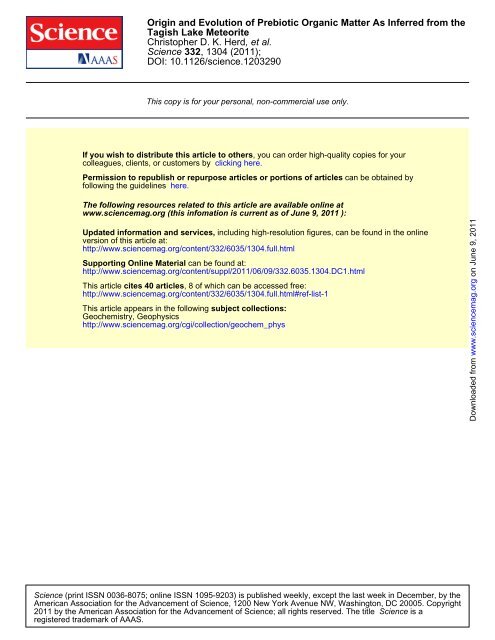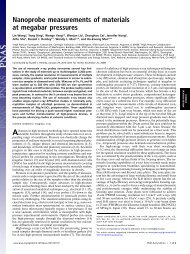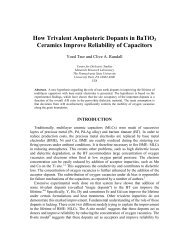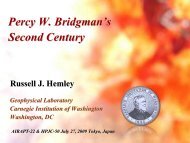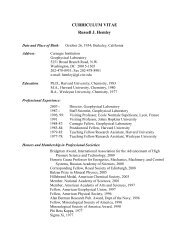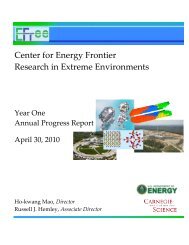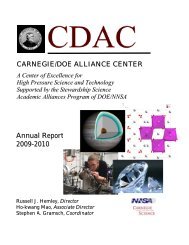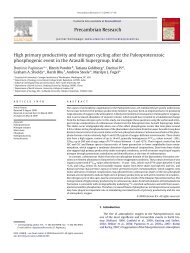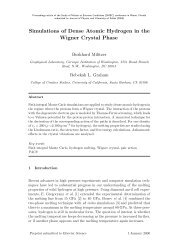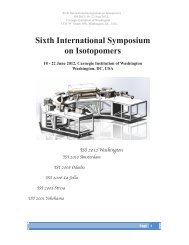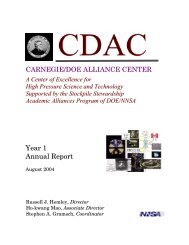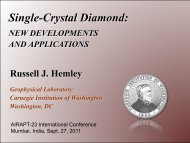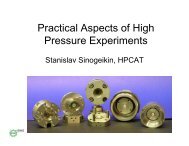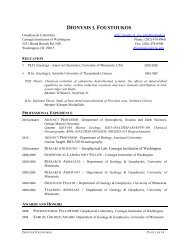Herd C. D. K., A. Blinova, D. N. Simkus, Y. Huang, R. Tarozo, C. M. O ...
Herd C. D. K., A. Blinova, D. N. Simkus, Y. Huang, R. Tarozo, C. M. O ...
Herd C. D. K., A. Blinova, D. N. Simkus, Y. Huang, R. Tarozo, C. M. O ...
You also want an ePaper? Increase the reach of your titles
YUMPU automatically turns print PDFs into web optimized ePapers that Google loves.
Origin and Evolution of Prebiotic Organic Matter As Inferred from the<br />
Tagish Lake Meteorite<br />
Christopher D. K. <strong>Herd</strong>, et al.<br />
Science 332, 1304 (2011);<br />
DOI: 10.1126/science.1203290<br />
This copy is for your personal, non-commercial use only.<br />
If you wish to distribute this article to others, you can order high-quality copies for your<br />
colleagues, clients, or customers by clicking here.<br />
Permission to republish or repurpose articles or portions of articles can be obtained by<br />
following the guidelines here.<br />
The following resources related to this article are available online at<br />
www.sciencemag.org (this infomation is current as of June 9, 2011 ):<br />
Updated information and services, including high-resolution figures, can be found in the online<br />
version of this article at:<br />
http://www.sciencemag.org/content/332/6035/1304.full.html<br />
Supporting Online Material can be found at:<br />
http://www.sciencemag.org/content/suppl/2011/06/09/332.6035.1304.DC1.html<br />
This article cites 40 articles, 8 of which can be accessed free:<br />
http://www.sciencemag.org/content/332/6035/1304.full.html#ref-list-1<br />
This article appears in the following subject collections:<br />
Geochemistry, Geophysics<br />
http://www.sciencemag.org/cgi/collection/geochem_phys<br />
Downloaded from www.sciencemag.org on June 9, 2011<br />
Science (print ISSN 0036-8075; online ISSN 1095-9203) is published weekly, except the last week in December, by the<br />
American Association for the Advancement of Science, 1200 New York Avenue NW, Washington, DC 20005. Copyright<br />
2011 by the American Association for the Advancement of Science; all rights reserved. The title Science is a<br />
registered trademark of AAAS.
REPORTS<br />
Origin and Evolution of Prebiotic<br />
Organic Matter As Inferred from the<br />
Tagish Lake Meteorite<br />
Christopher D. K. <strong>Herd</strong>, 1 * Alexandra <strong>Blinova</strong>, 1 Danielle N. <strong>Simkus</strong>, 1 Yongsong <strong>Huang</strong>, 2<br />
Rafael <strong>Tarozo</strong>, 2 Conel M. O’D. Alexander, 3 Frank Gyngard, 3 Larry R. Nittler, 3 George D. Cody, 4<br />
Marilyn L. Fogel, 4 Yoko Kebukawa, 4 A. L. David Kilcoyne, 5 Robert W. Hilts, 6 Greg F. Slater, 7<br />
Daniel P. Glavin, 8 Jason P. Dworkin, 8 Michael P. Callahan, 8 Jamie E. Elsila, 8<br />
Bradley T. De Gregorio, 9,10 Rhonda M. Stroud 10<br />
The complex suite of organic materials in carbonaceous chondrite meteorites probably originally<br />
formed in the interstellar medium and/or the solar protoplanetary disk, but was subsequently<br />
modified in the meteorites’ asteroidal parent bodies. The mechanisms of formation and<br />
modification are still very poorly understood. We carried out a systematic study of variations in<br />
the mineralogy, petrology, and soluble and insoluble organic matter in distinct fragments of the<br />
Tagish Lake meteorite. The variations correlate with indicators of parent body aqueous alteration.<br />
At least some molecules of prebiotic importance formed during the alteration.<br />
Carbonaceous chondrite meteorites are samples<br />
of kilometer-sized primitive asteroids<br />
that preserve to varying degrees the initial<br />
solid components of the solar protoplanetary disk<br />
[or nebula (1)]. As such, these meteorites are samples<br />
of the material that took part in planet formation<br />
nearly 4.6 billion years ago. The chondrites<br />
also preserve a record of the processes that occurred<br />
in their asteroid parent bodies, such as thermal<br />
metamorphism, aqueous alteration, and impact<br />
brecciation (1). Organic matter composes up to<br />
several weight percent of carbonaceous chondrites<br />
and includes macromolecular material<br />
and a variety of simpler molecules (2) that are<br />
generally referred to as insoluble organic matter<br />
(IOM) and soluble organic matter (SOM),<br />
respectively, because of their relative solubilities<br />
in typical solvents (3, 4). Organic matter in carbonaceous<br />
chondrites shares characteristics with<br />
material from other primitive extraterrestrial samples,<br />
including interplanetary dust particles (IDPs),<br />
samples of comet 81P/Wild 2 (5, 6), and some<br />
Antarctic micrometeorites (7). The common features<br />
of IOM from carbonaceous chondrites and<br />
comets suggest that there was a common source<br />
of such organic matter—the outer solar nebula<br />
and/or the interstellar medium—and that the<br />
1 Department of Earth and Atmospheric Sciences, University<br />
of Alberta, Edmonton, Alberta T6G 2E3, Canada. 2 Department<br />
of Geological Sciences, Brown University, 324 Brook<br />
Street, Providence, RI 02912, USA. 3 Department of Terrestrial<br />
Magnetism, 5241 Broad Branch Road, Carnegie Institution<br />
of Washington (CIW), Washington, DC 20015, USA.<br />
4 Geophysical Laboratory, 5251 Broad Branch Road, CIW, Washington,<br />
DC 20015, USA. 5 Advanced Light Source, Lawrence<br />
Berkeley Laboratory, Berkeley, CA 94720, USA. 6 Department of<br />
Physical Sciences, Grant MacEwan University, Edmonton, Alberta<br />
T5J 4S2, Canada. 7 School of Geography and Earth Sciences,<br />
McMaster University, Hamilton, Ontario L8S 4K1, Canada. 8 NASA<br />
Goddard Space Flight Center, Greenbelt, MD 20771, USA.<br />
9 Engineering and Science Contract Group, NASA Johnson Space<br />
Center, Houston, TX 77058, USA. 10 Naval Research Laboratory,<br />
4555 Overlook Avenue SW, Washington, DC 20375, USA.<br />
*To whom correspondence should be addressed. E-mail:<br />
herd@ualberta.ca<br />
diversity of organic matter in meteorites is the<br />
result of variable degrees of parent body modification<br />
(8).<br />
Earth’s carbon was provided by the accretion<br />
of early solar system solids. The accretion of<br />
meteorites and other asteroidal and cometary<br />
material by the early Earth may have been a<br />
source of intact organic matter that was necessary<br />
for the advent of life (9). Carbonaceous chondrite<br />
SOM includes molecules of prebiotic interest<br />
such as amino acids, nucleobases, monocarboxylic<br />
acids (MCAs), sugars, and polycyclic aromatic<br />
hydrocarbons (3). Some of these compounds<br />
may be the result of hydrothermal alteration of<br />
IOM in the meteorite parent bodies (10–12), but<br />
which compounds formed in this manner is an<br />
open question.<br />
Here we report on IOM and SOM in several<br />
individual stones of the Tagish Lake meteorite<br />
shower (13) that have experienced different levels<br />
of hydrothermal alteration (14). The meteorite<br />
is an ungrouped type 2 carbonaceous chondrite<br />
(it has affinities to both CI and CM meteorites)<br />
consisting of chondrules set in a fine-grained<br />
matrix that is dominated by serpentine and saponite<br />
clay minerals (15), and it has been linked to<br />
the primitive D-type asteroids (16). Lithological<br />
variability on the scale of individual stones may<br />
be attributable to different conditions of alteration<br />
and/or impact brecciation (15). The Tagish Lake<br />
meteorite contains a high concentration of organic<br />
matter, nearly 3 weight percent (wt %) (17).<br />
An unusual distribution of soluble organic compounds<br />
that are dominated by carboxylic and sulfonic<br />
acids, with only trace (part-per-billion) levels<br />
of amino acids, has previously been reported for<br />
the Tagish Lake meteorite, suggesting a distinct<br />
pathway of organic synthesis as compared to CI<br />
and CM meteorites (18, 19). Sub–micrometerscale<br />
carbonaceous globules that are often substantially<br />
enriched in 15 N and D and are thought<br />
to have formed in the interstellar medium or the<br />
cold outer solar nebula were previously identified<br />
in the Tagish Lake meteorite (5, 20), demonstrating<br />
the preservation of such material in spite of<br />
parent body alteration.<br />
Terrestrial contamination and modification,<br />
both abiotic and biotic, are perennial concerns in<br />
the study of meteorite organics. The first Tagish<br />
Lake meteorite specimens fell on a frozen lake,<br />
were collected without hand contact within a few<br />
days of the fall, and have been kept frozen ever<br />
since (21), providing an opportunity for the study<br />
of organic matter in a pristine meteorite sample.<br />
Much of what is known about the Tagish Lake<br />
meteorite derives from studies of this pristine<br />
material (18, 22). However, only a handful of the<br />
48 pristine stones have been examined in detail<br />
(21). We selected four specimens from among<br />
these stones on the basis of their macroscopic<br />
properties, in order to carry out a systematic study<br />
of the variations in organic matter in this meteorite<br />
and to test whether variations in IOM or SOM<br />
correlate with petrologic differences. We processed<br />
subsamples of each of the four specimens (5b,<br />
mass 4.3 g; 11h, 6.2 g; 11i, 4.7 g; and 11v, 5.6 g)<br />
in parallel, providing extracts for the analysis<br />
of SOM and IOM separates, material for x-ray<br />
diffraction, and polished mounts for microbeam<br />
analyses (13).<br />
All four specimens are composed of olivineand<br />
pyroxene-bearing chondrules and chondrulelike<br />
objects, compact lithic fragments, and isolated<br />
olivine or pyroxene grains, set in a fine-grained<br />
porous matrix dominated by clays, sulphides, magnetite,<br />
and carbonates. Based on the relative proportions<br />
of porous matrix and framboidal magnetite<br />
(15), and the increasing replacement of chondrule<br />
glass by phyllosilicates (23), the degree to which<br />
the specimens have undergone aqueous alteration<br />
is in the order 5b < 11h
REPORTS<br />
characteristics cover the range seen in the other<br />
three specimens. The macroscopic differences<br />
among the specimens are attributable to the proportions<br />
of the various components, as well as<br />
matrix grain size. For example, 11i, which is very<br />
dark and tends to shed a residue of black dust, has<br />
a lower proportion of chondrules and a smaller<br />
average matrix grain size ( 11h ><br />
11i ~ 11v (Table 1). The variations in H/C and dD<br />
observed in IOM in these specimens span almost<br />
the entire range found among the different carbonaceous<br />
chondrite groups (Fig. 1A). This lends<br />
credence to the suggestion that the variation in<br />
IOM elemental and isotopic compositions found<br />
in chondrites is the result of parent body modification<br />
of a common precursor (8). Furthermore,<br />
there is a linear correlation between H/C<br />
ratios and dD values (Fig. 1). Solid-state 13 Cand<br />
1 H nuclear magnetic resonance spectroscopy and<br />
carbon x-ray absorption near-edge spectroscopy<br />
[C-XANES (24)] (13) indicate that the decrease<br />
in the H/C ratio is accompanied by an increase in<br />
the proportion of aromatic C in the IOM as well<br />
as a considerable increase in aromatic substitution,<br />
probably aromatic condensation (13). The<br />
change in H/C was not accompanied by a substantial<br />
loss of C (Table 1), which may indicate<br />
that the aliphatic component in the Tagish Lake<br />
meteorite was converted into aromatic C, while<br />
undergoing H isotopic exchange with the altering<br />
fluid and/or preferential D loss. This apparently<br />
facile transformation is unexpected. It is most<br />
likely caused by hydrothermal alteration, as is observed<br />
in experiments involving hydrous pyrolysis<br />
or reaction with water at elevated temperature and<br />
pressure (11, 25), and differs from the scenario in<br />
which aliphatic C is selectively removed through<br />
reaction with an oxidant (26).<br />
High-spatial-resolution secondary ion mass<br />
spectroscopic (SIMS) measurements reveal that<br />
the isotopic differences observed in bulk IOM<br />
residues extend to submicrometer scales. IOM<br />
from sample 5b shows not only a higher average<br />
D/H ratio but also a much higher proportion of<br />
very D-rich submicrometer-sized isotopic hot<br />
spots (Fig. 1B) with more extreme D/H ratios<br />
than those from 11v [maximum dD ~20,000 per<br />
mil (‰) in 5b versus ~7000‰ in 11v]. These<br />
observations suggest that parent body alteration<br />
has substantially removed D, decreasing the D/H<br />
ratio on all spatial scales and reducing the number<br />
of hot spots. Similar variations in D enrichments<br />
and abundances between chondrites have been<br />
observed before, but never in a single chondrite.<br />
In contrast, the N isotopic distributions are similar<br />
except that 5b contains about twice the number<br />
density of 15 N hot spots (with d 15 N in both<br />
residues up to ~800‰). This difference in behavior<br />
of H and N isotopes supports observations<br />
in previous studies that D and 15 N enrichments in<br />
IOM tend to be decoupled (5). Isotopic hot spots<br />
are, in many cases, associated with carbonaceous<br />
nanoglobules (5, 20). Transmission electron microscope<br />
(TEM) examinations indicate that IOM<br />
from sample 5b has a significantly higher fraction<br />
(7.5%) of nanoglobules than does IOM from 11v<br />
(0.9%) (13). C-XANES (24) indicates the presence<br />
of two chemical classes of nanoglobules,<br />
one with a C functional group distribution similar<br />
to that in nonglobular IOM and one dominated<br />
by aromatic functionality (13). Aromatic-type nanoglobule<br />
spectra are seen in a higher fraction of<br />
nanoglobules from 11v as compared to 5b [50%<br />
versus 20% (13)]. Taken together, the SIMS,<br />
TEM, and XANES results suggest that 15 N-rich<br />
nanoglobules have been preferentially destroyed<br />
in specimen 11v by hydrothermal alteration. Moreover,<br />
the higher fraction of highly aromatic nanoglobules<br />
in the more altered sample supports the<br />
conclusion from the bulk data that the alteration<br />
largely affects the aliphatic component of<br />
the IOM.<br />
Based on IOM results, the degree of alteration<br />
reflected by the Tagish Lake specimens is 5b <<br />
Fig. 1. (A)PlotofH/C,a<br />
measure of the degree of<br />
aliphatic character, against<br />
H isotopic composition for<br />
the Tagish Lake specimens,<br />
including data on the Tagish<br />
Lake meteorite from<br />
previous work (8). Also<br />
shown are representative<br />
data from other chondrite<br />
groups after (8), including<br />
ordinary chondrites (OC).<br />
For reference, the H/C value<br />
of an aliphatic molecule<br />
with infinite chain length<br />
is 2; aromatic organic matter has a maximum H/C = 1 (benzene), and approaches low values (~0.1) as the<br />
number of fused aromatic rings approaches infinity. (B) MapsofdD/H values of IOM separates from Tagish<br />
Lakespecimens5band11v,derivedfromHandDraster ion images acquired with a Cameca NanoSIMS 50L<br />
ion microprobe.<br />
11h < 11i < 11v, which is consistent with the<br />
order inferred petrologically. Within this context,<br />
we examined the results of the SOM analysis to<br />
determine whether the hydrothermal alteration<br />
has resulted in the formation, modification, or<br />
destruction of soluble organic molecules and to<br />
elucidate the relationship between IOM and<br />
SOM during the alteration.<br />
MCAs dominate the water extracts of the<br />
Tagish Lake meteorite. MCAs, such as formic<br />
and acetic acids, play essential roles in biochemistry<br />
(11, 27, 28); higher homologs are the fatty<br />
acids that self-assemble into membrane-bound<br />
vesicles in meteorite extracts and are the possible<br />
precursors of cell membranes (29). We identified<br />
11 MCAs in all specimens, including most of the<br />
members of the homologous series of linear,<br />
saturated MCAs from C 1 to C 10 . One or two<br />
branched isomers were detected in all specimens<br />
with the exception of 5b, in which 17 branched<br />
isomers were detected, in addition to the 11 linear<br />
MCAs. Numerous alkyl-substituted phenols were<br />
also found exclusively in 5b. Although, as in previous<br />
studies, d 13 C values are generally consistent<br />
with terrestrial values, these MCA hydrogen<br />
isotopic compositions are D-enriched, consistent<br />
with an extraterrestrial origin (2): As measured in<br />
5b, dD (acetic), 247‰; dD (formic/propanoic),<br />
708‰; dD (butanoic), 562‰; dD (isopentanoic),<br />
697‰ (13). The observed concentrations of these<br />
low-molecular-weight MCAs are unusually high<br />
relative to those seen in other studies of carbonaceous<br />
chondrites [including Tagish Lake (18)],<br />
ranging from 42 to 250 parts per million (ppm)<br />
for formic and acetic acid (13). We attribute these<br />
large concentrations to the preservation of the<br />
meteorite below 0°C since its recovery, which<br />
has minimized the loss of volatile organics, such<br />
as formic acid, as well as the specifics of the<br />
analytical methods (13). In nearly all specimens,<br />
the concentrations of the straight-chain MCAs<br />
decrease in a logarithmic manner as the C number<br />
increases, with the exception of 5b, in which<br />
the acetic acid concentration exceeds that of formic<br />
acid. The d 13 C values of MCAs differ among the<br />
specimens (Fig. 2). All specimens have common<br />
d 13 C~–20‰ for formic acid, and higher homologs<br />
approach a constant value of ~ –5‰ (average<br />
nonanoic acid = –26 T 2‰) with increasing C<br />
number. The largest differences are observed<br />
in acetic acid, which ranges from +8‰ (11h)<br />
to –36‰ (5b). Of particular note is specimen 11h,<br />
which shows a decrease in d 13 C with increasing<br />
C number (Fig. 2).<br />
The differences in MCAs among the Tagish<br />
Lake specimens may be explained by differing<br />
degrees of parent body modification. With the<br />
exception of formic acid, specimens 5b and 11h<br />
contain the highest concentrations of MCAs, 2 to<br />
10 times greater than concentrations in 11i and<br />
11v (13), attributable to loss or destruction of<br />
these water-soluble compounds during progressive<br />
parent body alteration. The high proportion<br />
of branched isomers in specimen 5b suggests that<br />
it preserves a more primary suite of compounds<br />
Downloaded from www.sciencemag.org on June 9, 2011<br />
www.sciencemag.org SCIENCE VOL 332 10 JUNE 2011 1305
REPORTS<br />
(2). The MCA pattern for 11h shows a trend of<br />
decreasing d 13 C with increasing C number, comparable<br />
to results for Murchison (30). Whereas<br />
this trend has been attributed to the preservation<br />
of the signature of kinetically controlled C addition<br />
in MCA synthesis, which takes place in<br />
cold, interstellar, or nebular environments (31),<br />
our results, which suggest that specimen 11h is<br />
more altered than 5b, imply that such a pattern<br />
may be a secondary signature. One possible<br />
explanation for the pattern in this case is the<br />
preferential exchange of MCA carboxyl C with<br />
inorganic C during hydrothermal processing,<br />
analogous to the process that occurs in oil-prone<br />
source rocks on Earth (32). In the Tagish Lake<br />
meteorite, the presence of carbonate d 13 C~67‰<br />
(17) may provide a source of isotopically enriched<br />
carbonate for such exchange. Notably,<br />
formic acid concentration and C isotopic composition<br />
remain relatively constant among the specimens<br />
(13), which suggests that they are relatively<br />
unaffected by aqueous alteration (10)andmaybe<br />
inherited from preaccretionary material.<br />
Amino acid concentrations and enantiomeric<br />
excesses in the Tagish Lake specimens provide<br />
further evidence of the influence of parent body<br />
aqueous alteration on SOM. We determined<br />
the distribution and enantiomeric abundances of<br />
the one- to six-C aliphatic amino acids found in<br />
extracts of specimens, 5b, 11h, and 11i by ultraperformance<br />
liquid chromatography fluorescence<br />
detection and time-of-flight mass spectrometry<br />
(33). We measured stable C isotope analyses of<br />
the most abundant amino acids in 11h with gas<br />
chromatography coupled with quadrupole mass<br />
spectrometry and isotope ratio mass spectrometry.<br />
The total abundances of amino acids decrease<br />
in the order 11h (5.6 ppm) > 5b (0.9 ppm) > 11i<br />
(0.04 ppm). The abundances of many amino acids<br />
in 11i were below the analytical detection limit<br />
(
REPORTS<br />
served in 5b, were accreted, along with (presumably)<br />
amino acid precursors. The a-amino acids<br />
were probably produced during alteration on the<br />
Tagish Lake parent body, presumably by Strecker<br />
synthesis (37, 39), although other formation mechanisms<br />
for both a and other amino acids before<br />
their incorporation in the parent body have<br />
been suggested (40). Modest alteration may<br />
have produced light acetic acid and an initial<br />
complement of MCAs from IOM, by analogy<br />
with experiments (11), as well as a slight ee in<br />
isovaline, to provide the SOM characteristics<br />
observed in 5b. These components were then<br />
modified on the parent body through further hydrothermal<br />
alteration, resulting in reduction of<br />
aliphatic character and D/H in IOM, exchange of<br />
isotopically heavy C with MCA carboxyl C, production<br />
of glycine, and a fresh influx of racemic<br />
amino acids, as represented by organic matter in<br />
11h. By analogy with MCAs, the exchange of<br />
isotopically heavy C with amino acid carboxyl C<br />
may explain the positive d 13 C values of amino<br />
acids in 11h (such as glycine). The increase in<br />
IOM d 13 C with the degree of alteration (Table 1)<br />
is consistent with the loss of isotopically lighter<br />
C, associated with aliphatics, such as MCAs in<br />
11i and 11v. Further hydrothermal alteration resulted<br />
in further modification of IOM and decreases<br />
in overall concentration of MCAs in 11i<br />
and 11v and a nearly complete loss of amino<br />
acids in 11i. The conditions of hydrothermal alteration<br />
inferred by analogy with experiments,<br />
especially temperature (~300°C) (10, 11, 25), are<br />
at odds with the mineralogy and preservation of<br />
volatile organic compounds, which provide an<br />
upper limit of ~150°C (23). The Tagish Lake<br />
specimens may therefore have experienced alteration<br />
at lower temperatures than those in the<br />
experiments, with the more extensively altered<br />
samples having been subjected to longer periods<br />
of alteration, higher temperatures, and/or higher<br />
water/rock ratios (11).<br />
References and Notes<br />
1. E. R. D. Scott, A. N. Krot, in Treatise on Geochemistry,<br />
H. D. Holland, K. K. Turekian, Eds. (Elsevier Pergamon,<br />
Oxford, 2007), vol. 1, pp. 1–72.<br />
2. I. Gilmour, in Treatise on Geochemistry, H. D. Holland,<br />
K. K. Turekian, Eds. (Elsevier Pergamon, Oxford, 2003),<br />
vol. 1, pp. 269–290.<br />
3. O. Botta, J. L. Bada, Surv. Geophys. 23, 411<br />
(2002).<br />
4. J. R. Cronin, S. Pizzarello, D. P. Cruikshank, in Meteorites<br />
and the Early Solar System, J. F. Kerridge,<br />
M. S. Matthews, Eds. (Univ. of Arizona Press, Tucson,<br />
AZ, 1988), pp. 819–857.<br />
5. H. Busemann et al., Science 312, 727 (2006).<br />
6. S. A. Sandford et al., Science 314, 1720 (2006).<br />
7. J. Duprat et al., Science 328, 742 (2010).<br />
8. C. M. O. D. Alexander, M. Fogel, H. Yabuta, G. D. Cody,<br />
Geochim. Cosmochim. Acta 71, 4380 (2007).<br />
9. C. F. Chyba, P. J. Thomas, L. Brookshaw, C. Sagan,<br />
Science 249, 366 (1990).<br />
10. Y. <strong>Huang</strong>, M. R. Alexandre, Y. Wang, Earth Planet.<br />
Sci. Lett. 259, 517 (2007).<br />
11. Y. Oba, H. Naraoka, Meteorit. Planet. Sci. 41, 1175<br />
(2006).<br />
12. L. Remusat, S. Derenne, F. Robert, H. Knicker, Geochim.<br />
Cosmochim. Acta 69, 3919 (2005).<br />
13. Information on materials and methods is available as<br />
supporting material on Science Online.<br />
14. Hydrothermal alteration occurred early in the history<br />
of the carbonaceous chondrite parent bodies owing to<br />
accumulation of the heat of radioactive decay, so that<br />
liquid water was transiently present and percolated<br />
through the mineral matrix. The evidence for this<br />
process is preserved in mineral alterations. Furthermore,<br />
in the interior of the parent body, the temperature<br />
and pressure can rise high enough to produce<br />
hydropyrolysis of organic material.<br />
15. M. E. Zolensky et al., Meteorit. Planet. Sci. 37, 737<br />
(2002).<br />
16. T. Hiroi, M. E. Zolensky, C. M. Pieters, Science 293,<br />
2234 (2001).<br />
17. M. M. Grady, A. B. Verchovsky, I. A. Franchi, I. P. Wright,<br />
C. T. Pillinger, Meteorit. Planet. Sci. 37, 713 (2002).<br />
18. S. Pizzarello et al., Science 293, 2236 (2001).<br />
19. G. Kminek, O. Botta, D. P. Glavin, J. L. Bada, Meteorit.<br />
Planet. Sci. 37, 697 (2002).<br />
20. K. Nakamura-Messenger, S. Messenger, L. P. Keller,<br />
S. J. Clemett, M. E. Zolensky, Science 314, 1439<br />
(2006).<br />
21. R.K.<strong>Herd</strong>,C.D.K.<strong>Herd</strong>,Lunar Planet. Sci. XXXVIII, abstr.<br />
2347 (2007).<br />
22. P. G. Brown et al., Science 290, 320 (2000).<br />
23. A. J. Brearley, in Treatise on Geochemistry, H. D. Holland,<br />
K. K. Turekian, Eds. (Elsevier Pergamon, Oxford, 2003),<br />
vol. 1, pp. 247–268.<br />
24. A. L. D. Kilcoyne et al., J. Synchrotron Radiat. 10, 125<br />
(2003).<br />
25. H. Yabuta, L. B. Williams, G. D. Cody, C. M. O. Alexander,<br />
S. Pizzarello, Meteorit. Planet. Sci. 42, 37 (2007).<br />
26. G. D. Cody, C. M. O. D. Alexander, Geochim. Cosmochim.<br />
Acta 69, 1085 (2005).<br />
27. M. C. Anguera et al., J. Biol. Chem. 281, 18335<br />
(2006).<br />
28. G. K. Smith, W. T. Mueller, L. J. Slieker, C. W. DeBrosse,<br />
S. J. Benkovic, Biochemistry 21, 2870 (1982).<br />
29. D. Deamer, J. P. Dworkin, S. A. Sandford, M. P. Bernstein,<br />
L. J. Allamandola, Astrobiology 2, 371 (2002).<br />
30. Y. S. <strong>Huang</strong> et al., Geochim. Cosmochim. Acta 69, 1073<br />
(2005).<br />
31. G. Yuen, N. Blair, D. J. Des Marais, S. Chang, Nature<br />
307, 252 (1984).<br />
32. R. F. Dias, K. H. Freeman, M. D. Lewan, S. G. Franks,<br />
Geochim. Cosmochim. Acta 66, 2755 (2002).<br />
33. D. P. Glavin, J. P. Dworkin, Proc. Natl. Acad. Sci. U.S.A.<br />
106, 5487 (2009).<br />
34. R. Bowen, in Isotopes in the Earth Sciences, R. Bowen,<br />
Ed. (Kluwer, New York, 1988), pp. 452–469.<br />
35. D. P. Glavin, M. P. Callahan, J. P. Dworkin, J. E. Elsila,<br />
Meteorit. Planet. Sci. 45, 1948 (2010).<br />
36. J. R. Cronin, S. Pizzarello, S. Epstein, R. V. Krishnamurthy,<br />
Geochim. Cosmochim. Acta 57, 4745 (1993).<br />
37. E. T. Peltzer, J. L. Bada, G. Schlesinger, S. L. Miller,<br />
Adv. Space Sci. 4, 69 (1984).<br />
38. S. Pizzarello, M. Zolensky, K. A. Turk, Geochim.<br />
Cosmochim. Acta 67, 1589 (2003).<br />
39. E. T. Peltzer, J. L. Bada, Nature 272, 443 (1978).<br />
40. J. E. Elsila, J. P. Dworkin, M. P. Bernstein, M. P. Martin,<br />
S. A. Sandford, Astrophys. J. 660, 911 (2007).<br />
41. Where given, the errors are half the difference<br />
(standard error of the mean) between the compositions<br />
of two residues prepared from two separate aliquots of<br />
each specimen. Typically, the differences in elemental<br />
ratios and isotopic compositions are larger than the<br />
intrinsic measurement precisions. Where only one<br />
measurement was made, the uncertainties of the other<br />
samples are a guide to the likely uncertainties.<br />
Acknowledgments: Funding for this study was provided by the<br />
Natural Sciences and Engineering Research Council of<br />
Canada, Alberta Innovates, NASA (Astrobiology, including<br />
Carnegie Institution Astrobiology and the Goddard Center<br />
for Astrobiology; Origins of Solar Systems; Cosmochemistry<br />
and Postdoctoral Programs), the U.S. Office of Naval<br />
Research, the CIW, Grant MacEwan University, and the<br />
Carnegie Institution of Canada. The Canadian Institute for<br />
Advanced Research is thanked for hosting workshops that<br />
facilitated work on the MCAs. J. Kirby assisted with MCA<br />
analysis. R. Bowden carried out bulk IOM analyses. XANES<br />
data were acquired on the Scanning Transmission X-ray<br />
Microscope at beamline 5.3.2.2 of the Advanced Light<br />
Source, which is supported by the Director of the Office of<br />
Science, U.S. Department of Energy, under contract no.<br />
DE-AC02-05CH11231, and by a W.M. Keck Foundation grant<br />
to the CIW. Three anonymous reviewers are thanked<br />
for constructive comments that improved the manuscript.<br />
Supporting Online Material<br />
www.sciencemag.org/cgi/content/full/332/6035/1304/DC1<br />
Materials and Methods<br />
Figs. S1 to S5<br />
Tables S1 to S4<br />
References (42–50)<br />
25 January 2011; accepted 6 May 2011<br />
10.1126/science.1203290<br />
Activation of Visual Pigments<br />
by Light and Heat<br />
Dong-Gen Luo, 1,3 * Wendy W. S. Yue, 1,3,4 Petri Ala-Laurila, 5,6 King-Wai Yau 1,2,3 *<br />
Vision begins with photoisomerization of visual pigments. Thermal energy can complement<br />
photon energy to drive photoisomerization, but it also triggers spontaneous pigment activation<br />
as noise that interferes with light detection. For half a century, the mechanism underlying this<br />
dark noise has remained controversial. We report here a quantitative relation between a<br />
pigment’s photoactivation energy and its peak-absorption wavelength, l max . Using this relation<br />
and assuming that pigment activations by light and heat go through the same ground-state<br />
isomerization energy barrier, we can predict the relative noise of diverse pigments with<br />
multi–vibrational-mode thermal statistics. The agreement between predictions and our<br />
measurements strongly suggests that pigment noise arises from canonical isomerization.<br />
The predicted high noise for pigments with l max in the infrared presumably explains why they<br />
apparently do not exist in nature.<br />
Our visual system has an extremely high<br />
sensitivity to light under dark-adapted<br />
conditions (1). This feat requires a phototransduction<br />
mechanism with high amplification<br />
(2) and a thermally quiet visual pigment for minimizing<br />
noise. Thermal energy is a double-edged<br />
Downloaded from www.sciencemag.org on June 9, 2011<br />
www.sciencemag.org SCIENCE VOL 332 10 JUNE 2011 1307


